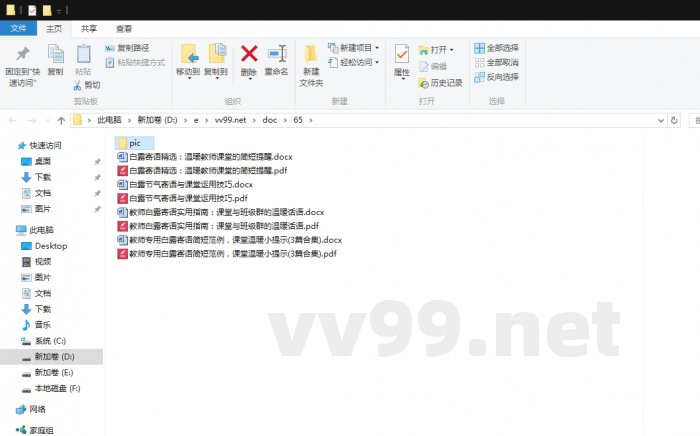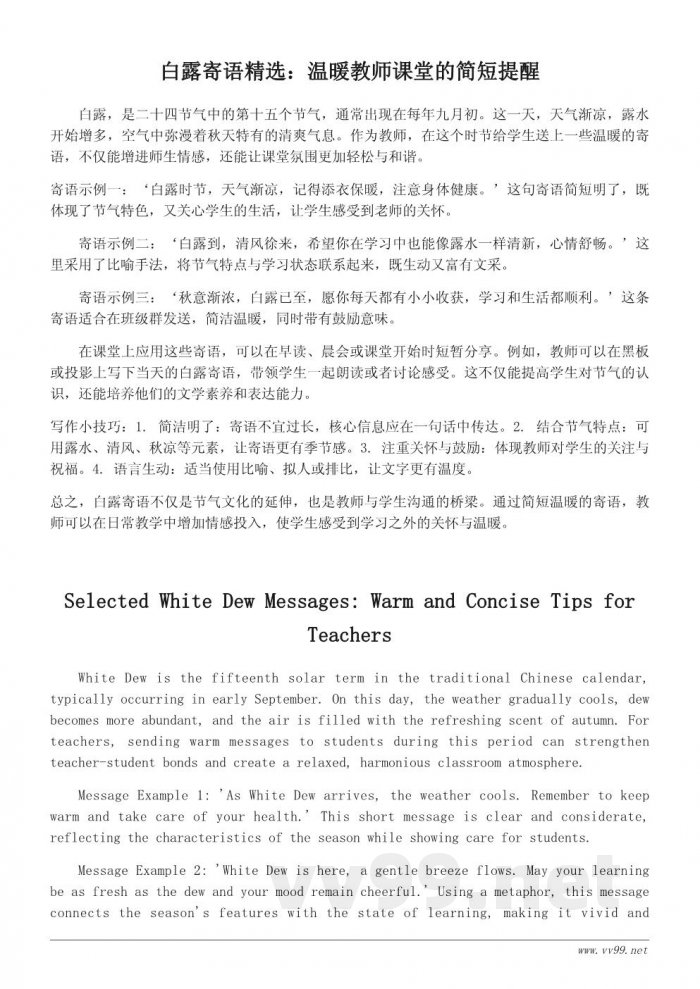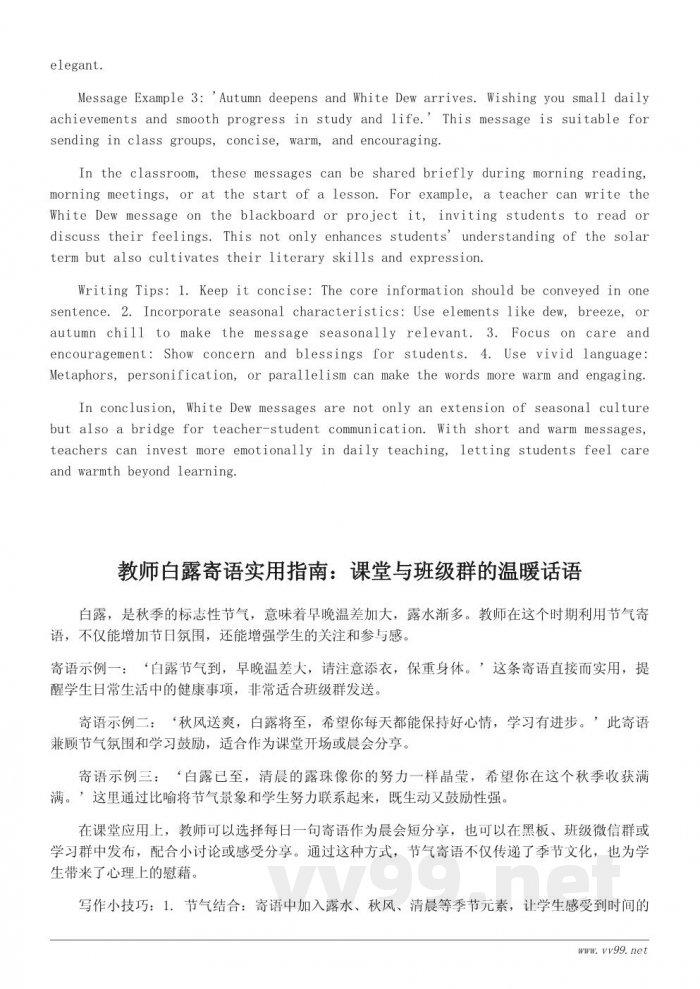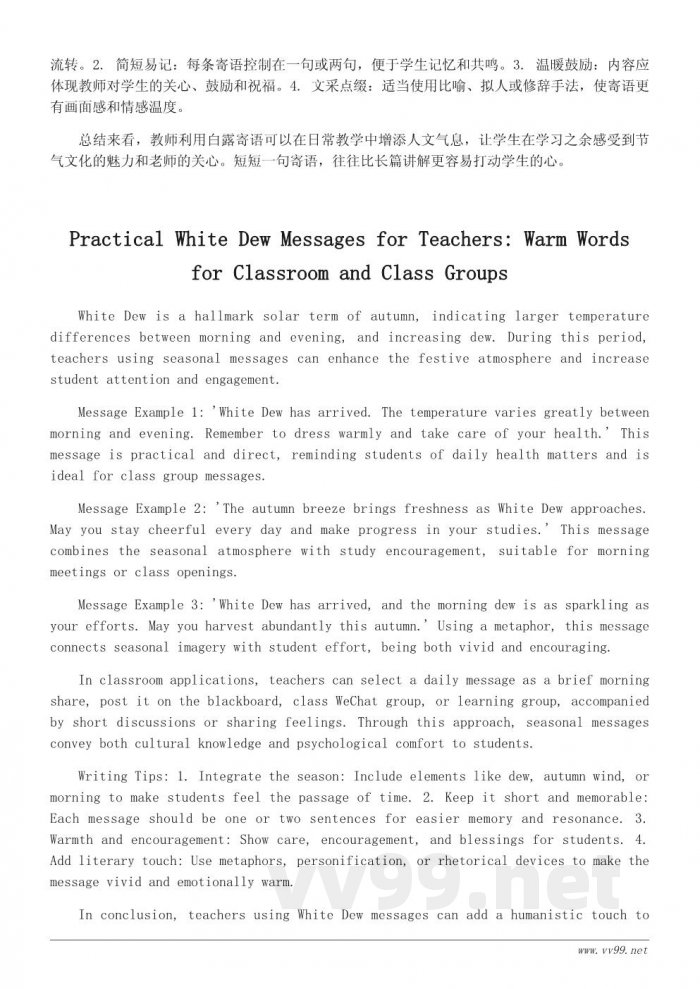白露寄语精选:温暖教师课堂的简短提醒
白露,是二十四节气中的第十五个节气,通常出现在每年九月初。这一天,天气渐凉,露水开始增多,空气中弥漫着秋天特有的清爽气息。作为教师,在这个时节给学生送上一些温暖的寄语,不仅能增进师生情感,还能让课堂氛围更加轻松与和谐。
寄语示例一:‘白露时节,天气渐凉,记得添衣保暖,注意身体健康。’这句寄语简短明了,既体现了节气特色,又关心学生的生活,让学生感受到老师的关怀。
寄语示例二:‘白露到,清风徐来,希望你在学习中也能像露水一样清新,心情舒畅。’这里采用了比喻手法,将节气特点与学习状态联系起来,既生动又富有文采。
寄语示例三:‘秋意渐浓,白露已至,愿你每天都有小小收获,学习和生活都顺利。’这条寄语适合在班级群发送,简洁温暖,同时带有鼓励意味。
在课堂上应用这些寄语,可以在早读、晨会或课堂开始时短暂分享。例如,教师可以在黑板或投影上写下当天的白露寄语,带领学生一起朗读或者讨论感受。这不仅能提高学生对节气的认识,还能培养他们的文学素养和表达能力。
写作小技巧:1. 简洁明了:寄语不宜过长,核心信息应在一句话中传达。2. 结合节气特点:可用露水、清风、秋凉等元素,让寄语更有季节感。3. 注重关怀与鼓励:体现教师对学生的关注与祝福。4. 语言生动:适当使用比喻、拟人或排比,让文字更有温度。
总之,白露寄语不仅是节气文化的延伸,也是教师与学生沟通的桥梁。通过简短温暖的寄语,教师可以在日常教学中增加情感投入,使学生感受到学习之外的关怀与温暖。
Selected White Dew Messages: Warm and Concise Tips for Teachers
White Dew is the fifteenth solar term in the traditional Chinese calendar, typically occurring in early September. On this day, the weather gradually cools, dew becomes more abundant, and the air is filled with the refreshing scent of autumn. For teachers, sending warm messages to students during this period can strengthen teacher-student bonds and create a relaxed, harmonious classroom atmosphere.
Message Example 1: 'As White Dew arrives, the weather cools. Remember to keep warm and take care of your health.' This short message is clear and considerate, reflecting the characteristics of the season while showing care for students.
Message Example 2: 'White Dew is here, a gentle breeze flows. May your learning be as fresh as the dew and your mood remain cheerful.' Using a metaphor, this message connects the season's features with the state of learning, making it vivid and elegant.
Message Example 3: 'Autumn deepens and White Dew arrives. Wishing you small daily achievements and smooth progress in study and life.' This message is suitable for sending in class groups, concise, warm, and encouraging.
In the classroom, these messages can be shared briefly during morning reading, morning meetings, or at the start of a lesson. For example, a teacher can write the White Dew message on the blackboard or project it, inviting students to read or discuss their feelings. This not only enhances students' understanding of the solar term but also cultivates their literary skills and expression.
Writing Tips: 1. Keep it concise: The core information should be conveyed in one sentence. 2. Incorporate seasonal characteristics: Use elements like dew, breeze, or autumn chill to make the message seasonally relevant. 3. Focus on care and encouragement: Show concern and blessings for students. 4. Use vivid language: Metaphors, personification, or parallelism can make the words more warm and engaging.
In conclusion, White Dew messages are not only an extension of seasonal culture but also a bridge for teacher-student communication. With short and warm messages, teachers can invest more emotionally in daily teaching, letting students feel care and warmth beyond learning.
教师白露寄语实用指南:课堂与班级群的温暖话语
白露,是秋季的标志性节气,意味着早晚温差加大,露水渐多。教师在这个时期利用节气寄语,不仅能增加节日氛围,还能增强学生的关注和参与感。
寄语示例一:‘白露节气到,早晚温差大,请注意添衣,保重身体。’这条寄语直接而实用,提醒学生日常生活中的健康事项,非常适合班级群发送。
寄语示例二:‘秋风送爽,白露将至,希望你每天都能保持好心情,学习有进步。’此寄语兼顾节气氛围和学习鼓励,适合作为课堂开场或晨会分享。
寄语示例三:‘白露已至,清晨的露珠像你的努力一样晶莹,希望你在这个秋季收获满满。’这里通过比喻将节气景象和学生努力联系起来,既生动又鼓励性强。
在课堂应用上,教师可以选择每日一句寄语作为晨会短分享,也可以在黑板、班级微信群或学习群中发布,配合小讨论或感受分享。通过这种方式,节气寄语不仅传递了季节文化,也为学生带来了心理上的慰藉。
写作小技巧:1. 节气结合:寄语中加入露水、秋风、清晨等季节元素,让学生感受到时间的流转。2. 简短易记:每条寄语控制在一句或两句,便于学生记忆和共鸣。3. 温暖鼓励:内容应体现教师对学生的关心、鼓励和祝福。4. 文采点缀:适当使用比喻、拟人或修辞手法,使寄语更有画面感和情感温度。
总结来看,教师利用白露寄语可以在日常教学中增添人文气息,让学生在学习之余感受到节气文化的魅力和老师的关心。短短一句寄语,往往比长篇讲解更容易打动学生的心。
Practical White Dew Messages for Teachers: Warm Words for Classroom and Class Groups
White Dew is a hallmark solar term of autumn, indicating larger temperature differences between morning and evening, and increasing dew. During this period, teachers using seasonal messages can enhance the festive atmosphere and increase student attention and engagement.
Message Example 1: 'White Dew has arrived. The temperature varies greatly between morning and evening. Remember to dress warmly and take care of your health.' This message is practical and direct, reminding students of daily health matters and is ideal for class group messages.
Message Example 2: 'The autumn breeze brings freshness as White Dew approaches. May you stay cheerful every day and make progress in your studies.' This message combines the seasonal atmosphere with study encouragement, suitable for morning meetings or class openings.
Message Example 3: 'White Dew has arrived, and the morning dew is as sparkling as your efforts. May you harvest abundantly this autumn.' Using a metaphor, this message connects seasonal imagery with student effort, being both vivid and encouraging.
In classroom applications, teachers can select a daily message as a brief morning share, post it on the blackboard, class WeChat group, or learning group, accompanied by short discussions or sharing feelings. Through this approach, seasonal messages convey both cultural knowledge and psychological comfort to students.
Writing Tips: 1. Integrate the season: Include elements like dew, autumn wind, or morning to make students feel the passage of time. 2. Keep it short and memorable: Each message should be one or two sentences for easier memory and resonance. 3. Warmth and encouragement: Show care, encouragement, and blessings for students. 4. Add literary touch: Use metaphors, personification, or rhetorical devices to make the message vivid and emotionally warm.
In conclusion, teachers using White Dew messages can add a humanistic touch to daily teaching, letting students feel the charm of seasonal culture and the teacher's care beyond academics. Sometimes, a short message is more touching than lengthy explanations.
小提示:上面此文档内容仅展示完整文档里的部分内容, 若需要下载完整文档请 点击免费下载完整文档 。





